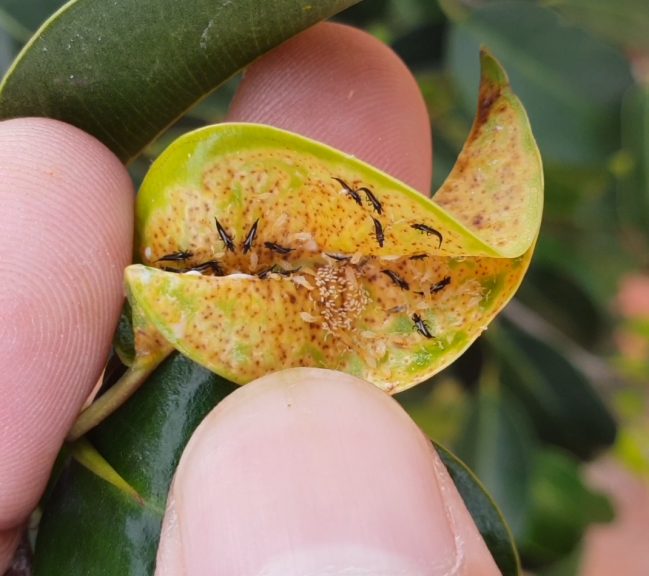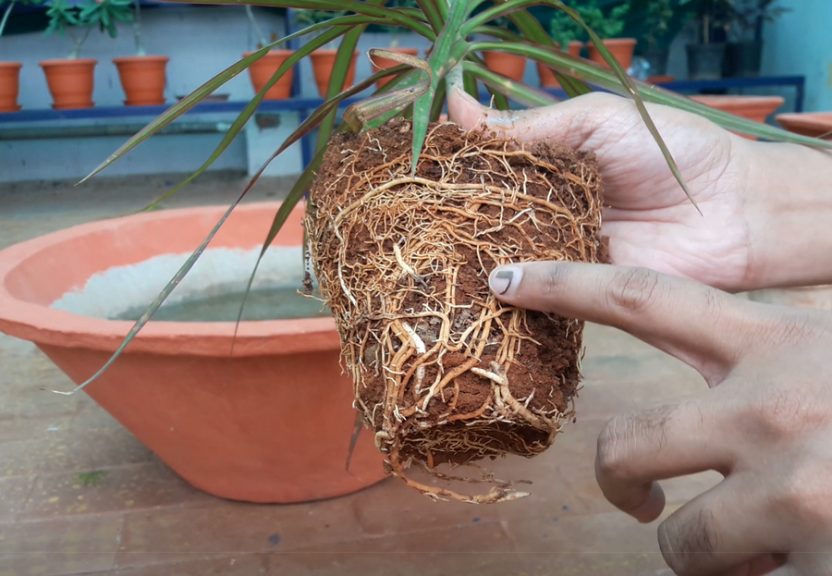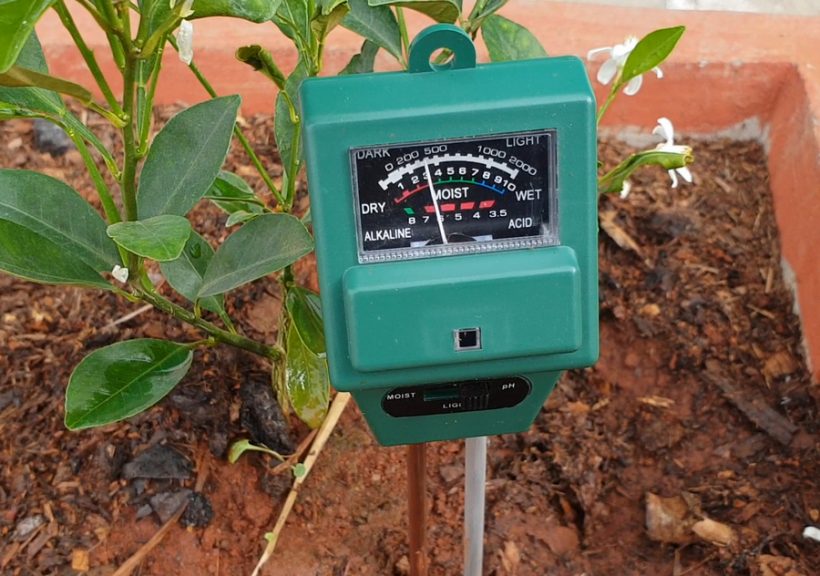When you see leaves of your plant curling – whether upwards or downwards, your plants are trying to tell you something! The first thing that should come in your mind is: the PLANT IS IN STRESS. Stress is more commonly seen in younger plants than the more established or mature plants.
Now, let’s look into different patterns of leaf curls with scientific concepts and reasons for each of these and solutions or remedies to be applied to treat the problem of leaf curl.
- Leaf margins curling downwards and drooping down – like wilting: The Common Cause of this is Under watering and excessive heat like in summer season. This indicates your plant is sad and stressed and requires Attention! This is a sign of too much heat and under watering. The solution is pretty simple! – Just water the plant thoroughly and you will see them come back to normal in few minutes.
- Leaf tips or margins curling upwards and folding. Upwards curling occurs because of environmental problems rather than nutrient problems. This could either be due to heat stress or wind stress. Leaves Curl upwards or fold upwards in an attempt to stop exposing or reducing the surface of the leaf for photosynthesis and reducing transpiration and hence overall dehydration. But one problem here is once it curls upwards, it’s not going to uncurl or come back to its normal shape. If the whole plant is suffering from this, you need to worry. But if it’s only few leaves curling at lower portions of the plant, not to worry, if younger shoots are healthy. What’s the Remedy for this leaf curl? Just shift the plant under a shade net away from too much hot sun and mist the plant with some water once or twice a day.

- Leaves curling down or drooping underneath itself with some yellowing. – A Sign of Over watering and an early indication of root rot. To save the plant, take out the root ball and repot in a fully dry soil for immediate solution and do not water for at least 2 days. You can also add some antifungal into the potting mix or in water.
- Leaf Curling with wrinkling and unhealthy look with patchy or punctate yellow spots or specks and visible pests like aphids, mealy bugs, etc – obviously indicate – pest attack is the cause of curling. Spraying neem oil weekly once will help in prevention as well as treatment.
- Leaf Curl Virus also needs a special mention. This commonly affects plants like peppers and tomatoes. If you come across this leaf curl and you have ruled out the other causes of leaf curl as discussed, then you should dispose the plant to prevent spread to other plants nearby.

- Nutritional deficiency can cause Leaf Curling. The Fact you must remember is: about 90% of all leaf curling or leaf injury like yellowing and so on can be attributed to environmental issues – not nutritional.
The main nutritional causes of leaf curling are Magnesium and Manganese Deficiency.
Magnesium Deficiency Curling shows on the middle to older leaves with patching yellowing as well. But the leaf veins stay green (inter-veinal chlorosis).
Manganese deficiency curling first starts showing at younger leaves. So this is how you differentiate between the two.
So, the first thing you need to do to support this diagnosis of nutritional cause of leaf curling is a Soil PH Test. Too much alkaline soil will inhibit the absorption of these micro nutrients by the roots. Simply adding micro nutrient powder will not help. First test the PH and correct the PH. You can make it Acidic by adding Alum or Vinegar.
Then, You can also Foliar Spray with Epsom salt solution if magnesium deficiency is suspected.
When you see leaves of your plant turning yellow or burning or browning at it tips or edges, it’s time to investigate and find out the possible cause and solution to it. You must be aware of these problems to keep your plants stress free and healthy! The First broad diagnosis that should come to your mind is – YOUR PLANT IS IN STRESS and then you further start investigating and finding out the exact reason for this problem. We will start listing the top 10 reasons for this problem in descending order.
10. Natural aging of the plant: This is one obvious reason for yellow leaves. If you see older leaves especially at the bottom of the plant turning yellow, just ignore it. This is not a reason to worry.
9. Pest Attacks: Sucking pests like aphids, mealybugs, whiteflies, thrips and mites can damage the leaves and can cause yellowing of leaves. You know Prevention is better than cure. These can be easily prevented or even treated organically using Neem oil spray regularly for treatment as well as prevention. Spray neem oil once every 15 days as a preventive measure and weekly once or even twice for treatment of these pests. You can check my detailed post on NEEM OIL.

8. Root bound plants: “Root bound” plant means that the roots of a plant have completely taken up the space within the pot, often circling and creating a dense web of roots. This can stress the plant and deprive it of nutrients, air, and water and this can result in leaf yellowing and stunted growth of the plant. Just repot the plant in a larger container or carefully perform root pruning if you wish to use the same container.

7. Transplant Shock: This is another reason for leaf yellowing and leaf drop. This is the period of stress to the plant when you just repot a plant. You can solve this to a certain extent by repotting your plant carefully and after repotting for the next one week keep the plant in shade away from direct sunlight. Water the plant once thoroughly with Epsom salt solution to counter this transplant shock. 5 to 10 gms of Epsom salt per litre of water is the recommended dosage. You can watch my detailed video on the 10 golden rules of Repotting a plant.
6. Fertilizer Overuse: If you observe a strange pattern to yellowing of leaves, like if the veins on the leaves are green and the tissue is getting yellow or the edges or tips are yellow or looking like burnt along with bud drop off or fruit drop off, then it is mostly due to fertilizer misuse.
Commonly overuse of fertilizers is the problem, so it is important to use fertilizer at the recommended dosage. This problem is more common with the use of chemical fertilizers like Urea, DAP or NPK granules and not a problem with organic fertilizers.
And moreover, people tend to use too much fertilizer on their plants to make them grow faster, especially newbie gardeners. But what it actually does is, it creates a toxic effect on the plant which “burns” the leaves and turns them yellow.
5. High Soil PH – that is too alkaline soil: This can also be one of the reasons for leaves turning yellow. This is little difficult to diagnose unless you have a soil ph testing gadget. This simple ph testing gadget will give you a rough idea about the soil PH whether acidic or alkaline soil. Most plants need a slightly acidic ph of around 6.5 for best absorption of nutrients.

4. Temperature: Leaves start turning yellow when it is either too hot or too cold. In terms of the cold temperatures, like for example adenium plants, the leaves start yellowing in winter and eventually fall off and the plant goes into the dormant state in winter. That’s called Winter Dormancy and applies to many other plants as well.
3. Sunlight: Reduced exposure to light is another common reason for plant leaves to turn yellow because not enough light is reaching the plant for photosynthesis. Similarly, Too much exposure to hot direct sun is another common reason for tips and edges of leaves to turn dry and brown. This can be corrected easily by knowing your plant by its name or atleast whether it’s a sun loving plant or a shade loving plant. Knowing a plant by its name is very important to learn about its care tips especially its light requirement and provide optimum exposure to sunlight. A simple free app to know a plant id is google lens app provided by google. You can watch my detailed episode on GOOGLE LENS.
2. Improper Watering: We will discuss this in detail, please watch carefully to understand the concepts. Improper watering can present as either leaf yellowing or leaf drying or leaf burning at tips and edges. The most common reason that plants’ leaves turn yellow is because of moisture stress, which can be from either over watering or under watering. Similarly, the most common cause for brown leaf tips or brown edges on leaves is the plant not getting enough water, I repeat, the plant NOT GETTING ENOUGH WATER which can be due to several reasons apart from you not watering the plant adequately.
- First of all check whether you are adequately watering the plant by checking the soil surface for moisture by dipping one or two inches of you finger. If you are forgetting to water the plant, rectify this problem immediately, especially for water loving plants. But this does not mean you have to over water them which is actually more dangerous than under watering and can result in root rot.
- The roots may be constricted and unable to pick up or absorb the water adequately, especially in container gardening. Also Too Much Clay rich Soil is another cause of constricting the roots tightly. So Increasing watering to resolve this issue is not the solution because there is a possibility of root rot with overwatering. Hence best solution to this is repot the plant in a larger container and in a loose well draining soil. A simple hack to get rid of clayey soil while repotting you plant is to soak the clay rich root ball for few minutes in a bucket of water to dissolve this soil and then repot this in a well draining soil.
- The soil does not hold the water and drains out too quickly. If your soil is too much sandy or over draining soil with lot of sand, the water may simply be draining away too fast and this may be causing water deficiency and brown edges on leaves. Improve the soil with other stuff like organic material and mixing some garden soil and other stuff like cocopeat, perlite, vermiculite, etc which will hold onto the water better. An ideal well draining soils is the one which drains out neither too quickly nor too slowly. A Simple and a rough Test to check whether your soil is perfectly well draining. When you thoroughly water your plant, it should drain out from the drainage hole in about 1 to 2 minutes, neither quicker nor too late.
- The roots may be damaged. Like while digging or even repotting or too much root pruning of a root bound plant, this can cause root damage and reduced water uptake. In this case, correct the problem that is causing the root damage and then do some good pruning on the plant branches to reduce its water requirement so that the root system recovers from this stress.
- The fifth reason for the sides of a leaf to turn brown is a high salt content in the soil either using hard water (salty water) to water the plants or Over use of Fertlizers. To overcome this start watering with soft water and also if over fertilized – flush the pot with large amounts of soft water keeping it in sunlight and properly opening the drainage holes of the container, so that the salty water or the fertilizer flushes out easily out of the pot.
One Simple Common sense Hint here for watering is: Generally, Indoor plants are more prone to over watering and outdoor plants are more prone to under watering.
- Leaf Chlorosis due to Nutritional deficiencies, either due to poor quality potting soil or absorption issues due to improper soil PH. Lack of uptake of major and minor nutrients in the plant like nitrogen and also certain mineral deficiencies like iron, manganese, zinc and other can cause unique leaf yellowing patterns. You can read my detailed post on diagnosing these various patterns of leaf yellowing due to nutritional deficiency.
Before we start displaying the various leaf patterns, you must understand some basics in order to diagnose this problem of nutrient deficiencies in plants and start the right treatment to save your plants. Because directly jumping in to adding too many supplements can burn or kill your plant.
Plant nutrients fall into 2 categories: macronutrients and micronutrients. Macronutrients are those elements that are needed in relatively large amounts. They include the three major ones – nitrogen, phosphorous, potassium, that’s NPK and also sulfur, calcium and magnesium. Micronutrients are those elements that plants need in very small amounts, like iron, boron, manganese, zinc, copper and molybdenum.
Most of the times, except in container gardening, these nutrients may be present in the soil. So before adding supplements you have to diagnose your condition by checking these 3 problems or factors:
- The problem may be with the roots – not able to absorb or uptake these nutrients. This can be due to root disease or improper watering. Because these nutrients are taken up by the roots only in the presence of moisture.
- Soil PH may not be right. Most plants need a PH of around 6.0 for proper absorption of nutrients by the roots. Having this little PH meter will certainly help you rectify this problem. You can find related posts on altering soil PH.
- Pest attacks which can sometimes resemble the patterns of nutrient deficiencies, especially the sucking pests like aphids. Make sure you thoroughly examine your plants.
Now having said that, let’s jump
into identifying the various leaf patterns of discoloration and distortion and
diagnose this problem. But always Keep in mind that each plant variety is
different and may display different symptoms. And also the damaged leaves may not come back
to normal after treatment but the new leaves will certainly come out healthy
and lush after treatment.
Let’s start with:
- Nitrogen Deficiency: you will notice complete yellowing of the older leaves generally at the bottom of plants. The younger leaves are often healthy and green. This is because, nitrogen is a mobile nutrient which moves up from the lower parts of the plant to the growing ends as a compensatory mechanism and hence the older leaves donate nitrogen and show complete yellowing including the veins and the entire leaf surface. The solution to this is simply adding a good nitrogen rich compost like decomposed cow dung or horse dung. But before adding, please rule out the problems of improper watering and soil PH that we already discussed.
- Calcium Deficiency: Here the new leaves are affected and may show yellowing, distortion and even burnt tips due to necrosis or death of the tip tissues. Blossom End Rot (BER) seen in tomatoes and squashes is the best example of this. We have discussed this problem and treatment in detail in my previous post.
- Magnesium Deficiency: Magnesium is also a mobile nutrient and hence The older leaves first turn yellow at the edges and surface – called interveinal chlorosis, meaning yellowing between the leaf veins. The veins as you can see, stay green, giving the leaf a marbled appearance. Remember, Magnesium is the central most atom in the chlorophyll molecule which imparts green colour to leaf. Foliar Spraying or watering the plant with 1 teaspoon Epsom salt per litre of water will give great results.
- Iron Deficiency: Iron is an immobile nutrient and hence cannot be carried upto the younger leaves from older leaves for compensation. So the leaf yellowing is first evident at the tips or the younger leaves. The pattern is similar to magnesium – the interveinal yellowing. This is actually a common pattern and most often due to alkaline soil ph which prevents proper absorption of iron by the roots. Hence its also called as lime induced chlorosis. The treatment for this is actually rectifying the soil ph to around 6, if its alkaline. Another method to bypass this problem is foliar spray of a micronutrient solution or compost tea.
- Phosphorous and Potassium Deficiencies: These are very much similar and plants show stunted growth plus leaf chlorosis like leaves turning darker or purplish. But this is difficult to identify and depends on the type of plant. Isolated Potassium deficiency usually exhibits yellowing starting at the tip or the margin of the leaf with the center being still green.
- Last but not the least, you must be aware of a condition called YELLOW VEIN CHLOROSIS. Here only the leaf veins turn yellow while the rest of the leaf shows normal green colour. This usually happens in winter or the dormancy period due to reduced nitrogen uptake by the roots from the soil in low temperatures.
Now the Universal Treatment Solutions for all these problems:
You have two options: First one is Making The Universal Cocktail Fertilizer mixture.
And the Second option is Vermicompost – which is rich is almost all micronutrients. Adding a handful every 15 days will keep your plants healthy and high yielding.
